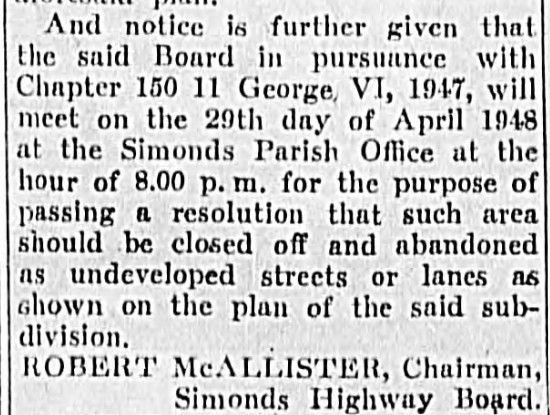I do not know a lot about East Saint John, New Brunswick. A friend shared an 1875 map book with me and looking at this 1875 map of East Saint John peaked my interest. I saw the name Tisdale (also the name of a town in Saskatchewan) and I got curious. I know we have a Tisdale Lane, and I see what looks like plans for a Tisdale named sort of subdivision. I am intrigued.
I want to give a special shout out to the Provincial Archives of New Brunswick and the University of New Brunswick Archives and Special Collections. The access to digitized primary sources, along with some newspapers, has proven invaluable.
1875 map below: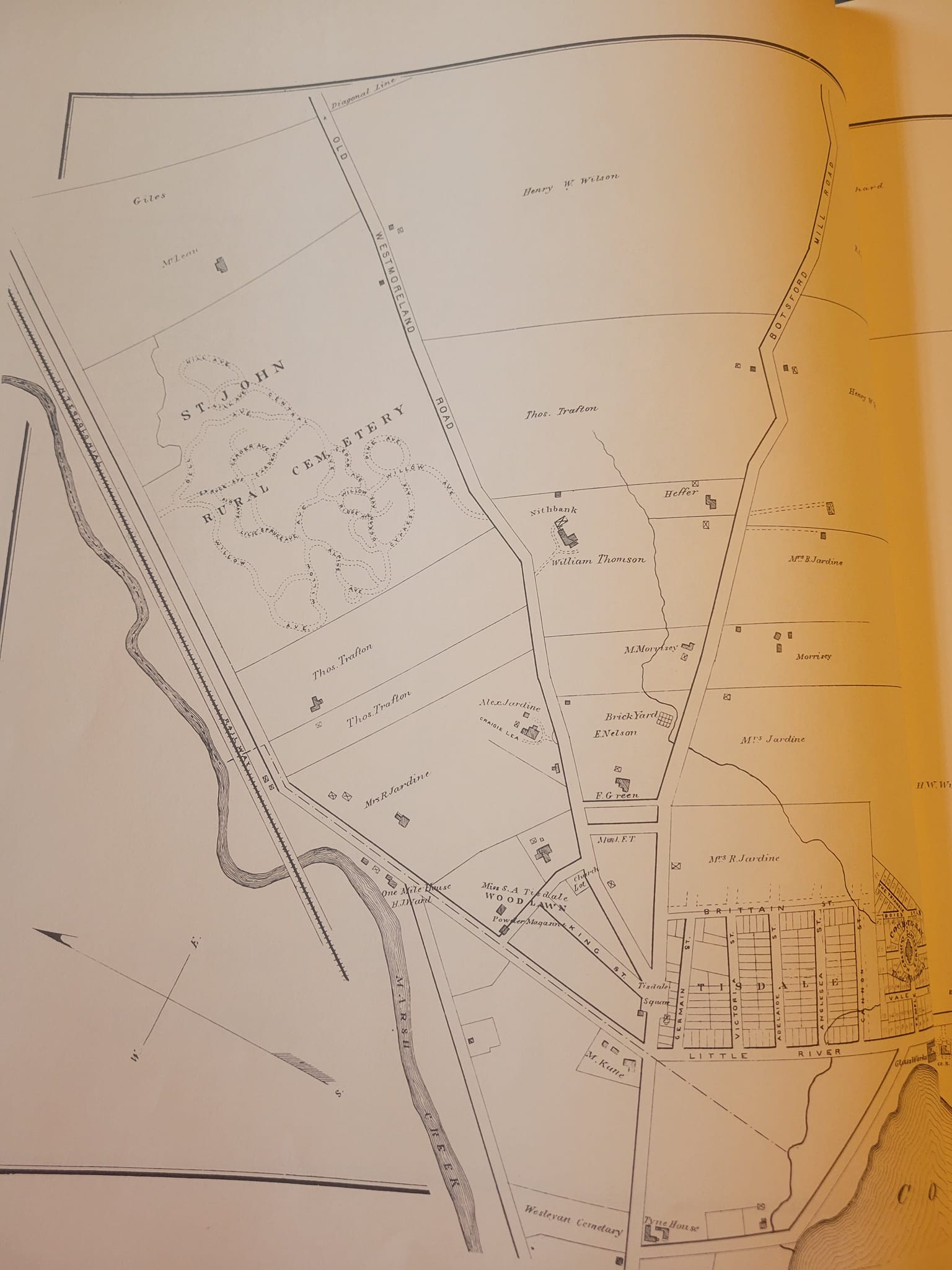
The plan, as envisaged above, does not seem to have come to realization and I want to know more.
This is the same area in 2025. Not the only reference to Tisdale is a little dead end lane.

I showed the map to a friend who pointed out it was a Miss not a Mrs who owned the property around Tisdale Square so I started my research here.
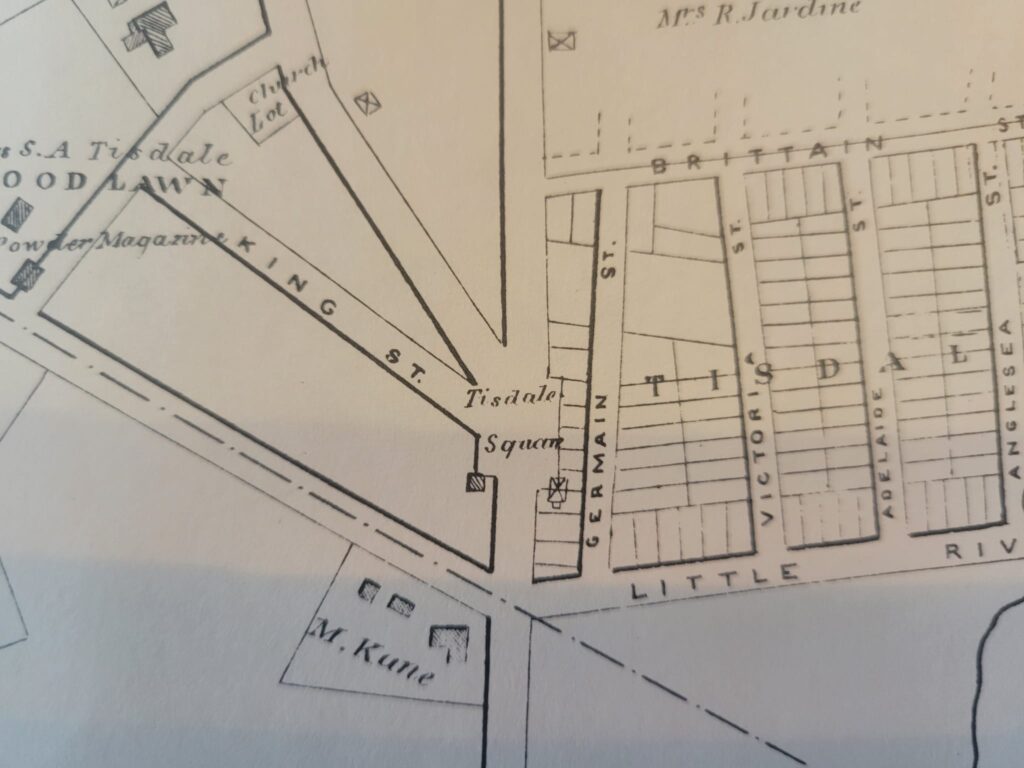
Miss S. A Tisdale, as noted on the map is Sarah Ann Tisdale – commonly called Ann. She owned Woodlawn and the accompanying powder magazine.
Ann Tisdale was the daughter of Walker Tisdale (1783-1857) and Eleanor Brittain Tisdale (1786-1860). Walker’s brother John also married a Brittain – Sarah Ann Brittain.
An 1888 Saint John Globe article describes Eleanor Brittain’ family: “To the Editor of ‘Boston British American Citizen’: Replying to the Provincialist’s inquiry to your last, the following facts will be of interest.: James Brittain came from New Jersey. He wished to take no part in the Revolutionary controversy. This rendered him obnoxious to the Rebels. His house was surrounded by a party of thirty who robbed and plundered him at pleasure. He escaped to the woods where his wife fed him for nearly a month. Emerging from his hiding place he joined the New Jersey Volunteers commanded by General Skinner, the last royal attorney general of New Jersey. He raised a company of 70 men whom he engaged to bear arms against the rebels. He was engaged in a number of battles; in one he was taken prisoner and doomed to suffer death. The day before that appointed for his execution, he broke prison, swam the Delaware, and joined his corps. In 1782 he was an ensign in the Volunteers and at the termination of the war, a lieutenant. In 1783 he went to Saint John, N.B. in the ship “Duke of Richmond” and was the grantee of a city lot. He received half pay in consideration of his past service. He was a colonel of the New Brunswick militia and at his decease the oldest magistrate in Kings Co. He died in Greenwich in that county in 1838 at the age of 87. Ten children survived him, of whom many descendants are now living in New Brunswick. His widow, Eleanor Brittain died at Greenwich in 1846, aged 94. His daughter, Eleanor married Walker Tisdale of Saint John. (sgd) James H. Stark.”
An 1894 Saint John Globe article noted that “The late Walker Tisdale, Esq., whose portrait with that of the late Mrs. Tisdale, was presented to the Historical Society last eve., was not the first child born in the city of Loyalist parentage. He was not born in the city at all, but on board one of the vessels which brought the Loyalists from New York to this place. The master of the ship in which his parents were was a Capt. Walker, and in recognition of the care and attention which he bestowed upon the mother and child, the boy was named Walker Tisdale.” It seems that both the Tisdale and Brittain families were on the Duke of Richmond as Loyalist evacuees.
The following images were not found in the NB Museum images database and as the museum is currently closed, I cannot ask about access. The images were found on a Government of Canada site and are ca. 1845. I suspect these are the images donated to the Historical Society.
Walker Tisdale

Eleanor Brittain Tisdale

Walker Tisdale was born en route to New Brunswick with his Loyalist parents. With the exception of a sister, Walker’s siblings and parents subsequently left the province. Walker moved into Saint John and became a successful merchant. He was a strong supporter of protecting the Loyalist Burial Grounds in Uptown.
An exciting 1894 article describes the Walker home in east Saint John. The article indicates that Walker bought the estate from Ewing’s creditors “About one mile from St. John, near the Marsh Road, the tourist in that region cannot fail to observe a somewhat remarkable building or buildings of stone construction, known as the powder magazine, the haunted house, etc. The house and barn were built in 1825 by an English gentleman by the name of Ewing. He was interested in the lumber business of the period. The house was thoroughly built and fitted up in the best style at the cost of $6,000. The barn, originally, had a wide entrance of sufficient size to drive a carriage with its portals. As a tout ensemble it was calculated to afford sufficient accommodation for a comfortable home. Mr. Ewing unfortunately got into business difficulties before he had a chance to occupy his home and very suddenly shuffled off this mortal coil. The creditors, it is said, not pleased with all the effects in sight to satisfy their claims, arrested the body. The property subsequently in 1836 was purchased by Walker Tisdale and has remained in the family to this date. The stone barn was used as a powder magazine and during the Fenian excitement was guarded by British troops. About the year ’36, within a short distance of the house aforesaid, a brutal murder was committed. A man by the name of Totten was killed in an altercation with two men named Culbert and Smith. There was a woman in the question. The said woman, however, who was the principal witness, swore she was not present and for the want of direct evidence, the suspected parties got clear. The damaging point rest on on an apron of muslin delaine of curious pattern worn by the woman who was in Potter’s company on the night of the murder. It could not be found. Had it been found, both Culbert and Smith would probably have been hanged. Twenty years afterwards, Mr. Addison, who has been overseer of the estate since it became the Tisdale property, when pulling down a stone wall just where the murdered man was found, discovered the last clue in the shape of the blood stained apron wonderfully preserved, showing conclusively that the woman was present and had used her apron for some purpose in the struggled.” The property, in the 1894 newspaper article, was pictured below and this is the only image I have found thus far:
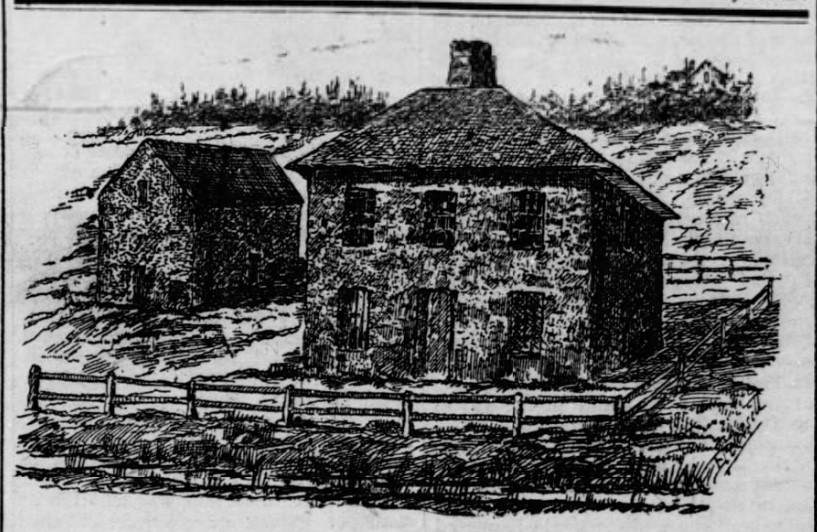
An 1855 Act to provide improved sewer and water facilities notes the following changes and describes the Woodlawn property owned by Walker Tisdale:
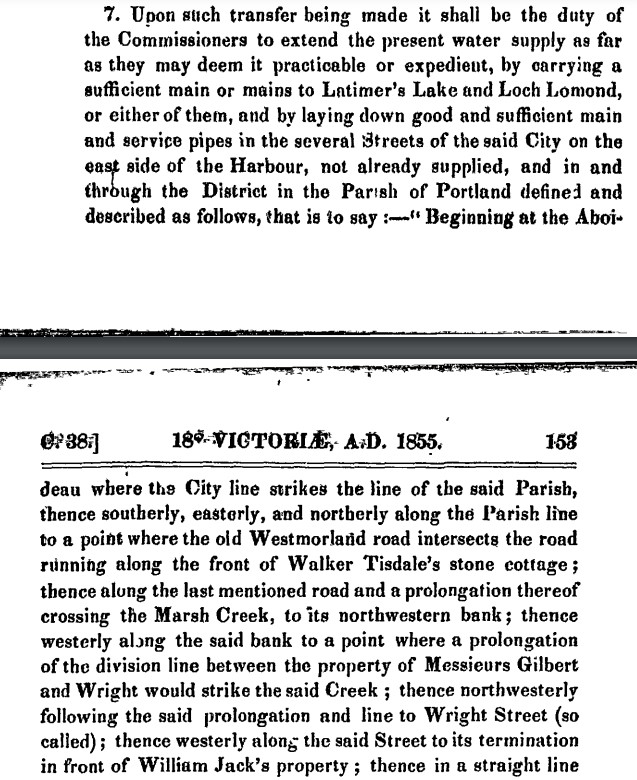
McAlpine Directories interchangeably describe the home as located on Old Loch Lomond Road and Westmoreland and called Woodlawn and Wood Lawn.
It appears James Ewing’s property, which later was owned by Walker Tisdale, was beside property already owned by Walker Tisdale.
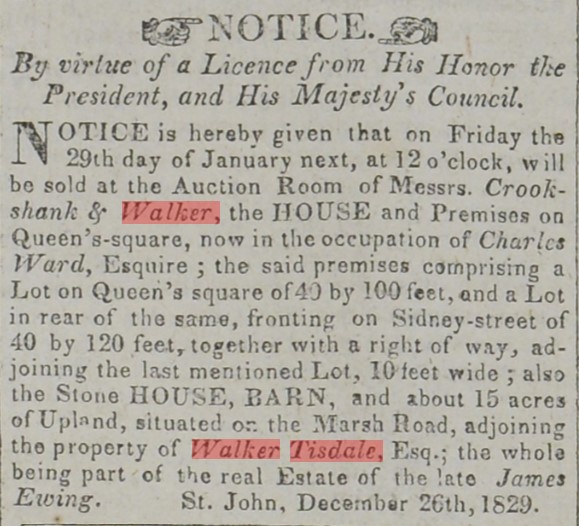
Did Walker Tisdale have some money troubles in 1833? See the Sheriff’s Sale which lists his properties in Portland and Simonds Parishes, and Uptown.
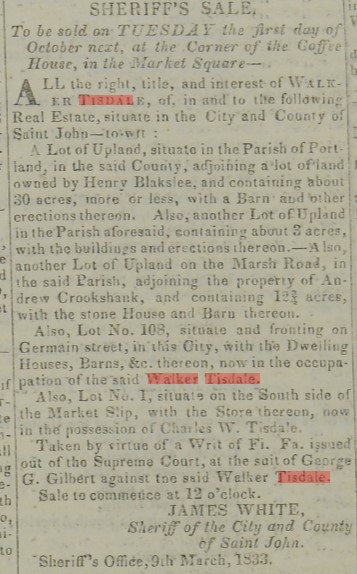
Walker and Eleanor Tisdale made the Woodlawn property the home for their children: Charles William (1807-1840), Sarah Ann (1810-1891), Jane Francis (1811-1881), and Thomas Ernest Gilbert Tisdale (1819-1875). Thomas married and had no children. Ann and Jane did not marry nor have children. Charles married.
Charles and Agnes Cannon married in Liverpool in 1832.

Charles’ daughter Agnes Cannon Tisdale died in Liverpool, England one month before Charles died. She is noted as dying 30 Dec 1839, age 6-7, and buried at St. James Garden Cemetery in Merseyside in Liverpool. Charles died soon after in 1840.
![]()
Saint John, NB newspaper indicates that Charles died in “Liverpool, England, 30th Jan., age 34, Charles W. TISDALE, Esq., merchant of that place and eldest s/o Walker TISDALE, Esq. of (St. John) city. On 30th Dec., Mr. T. was called to experience the painful dispensation of the disease, by scarlet fever, of his eldest child Agnes Cannon TISDALE, age 7, whose death he survived only one month. Mr. T. was a native of this city, married a daughter of David CANNON, Esq., of firm Cannon & Miller of Liverpool, removed to that city.”
Charles left the following daughters in England all baptized at St. Bride, Toxteth, Liverpool: Eleanor (baptized 1835, likely born 1834) , Jane (baptized 1836) , and Sarah Ann (baptized 1838) who shared the same names as his mother and sisters.
Charles and Thomas donated a stained glass window to Trinity Anglican Church in Saint John in memory of their parents. See details below and a special thanks to the church for the images!
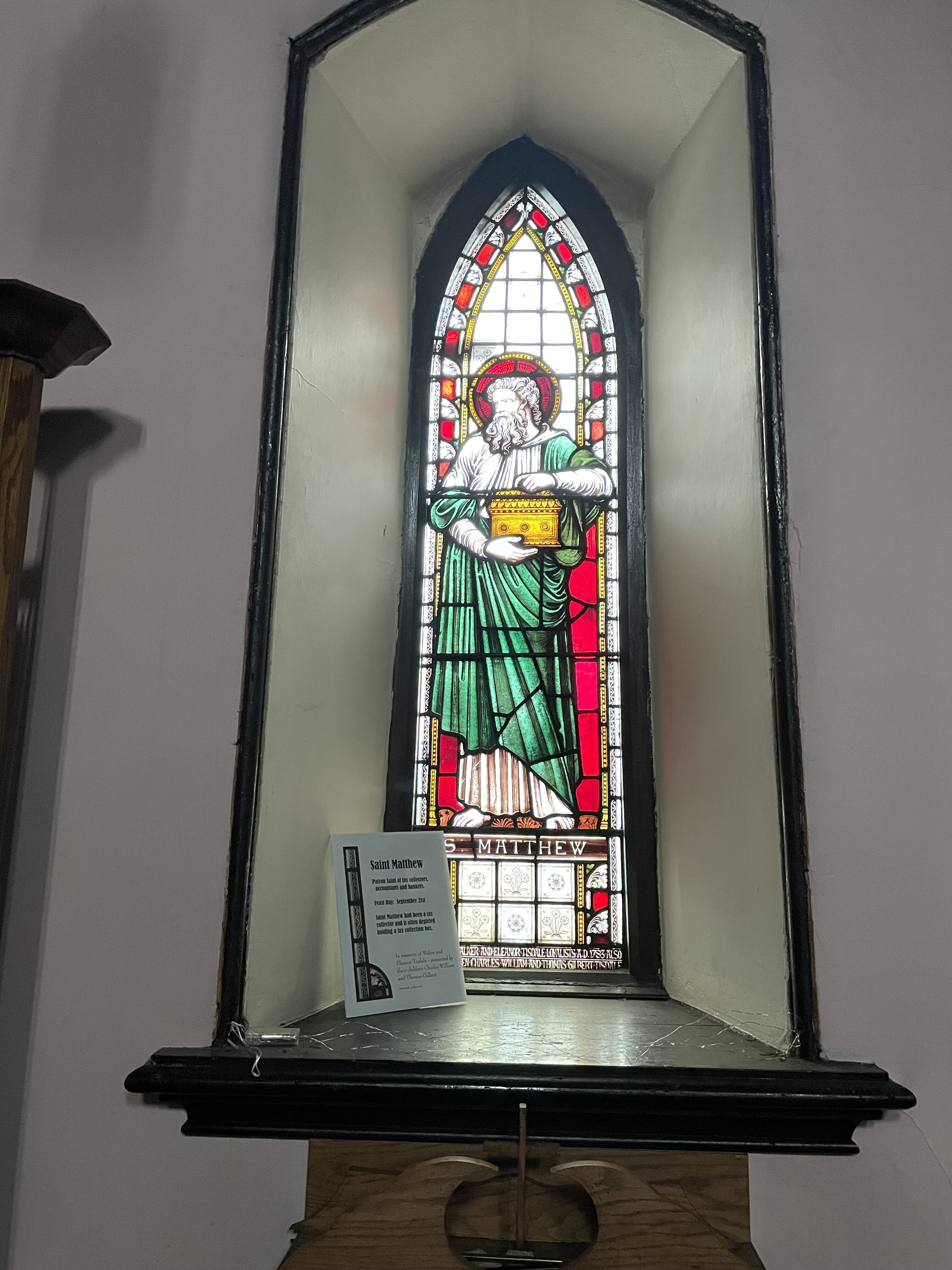
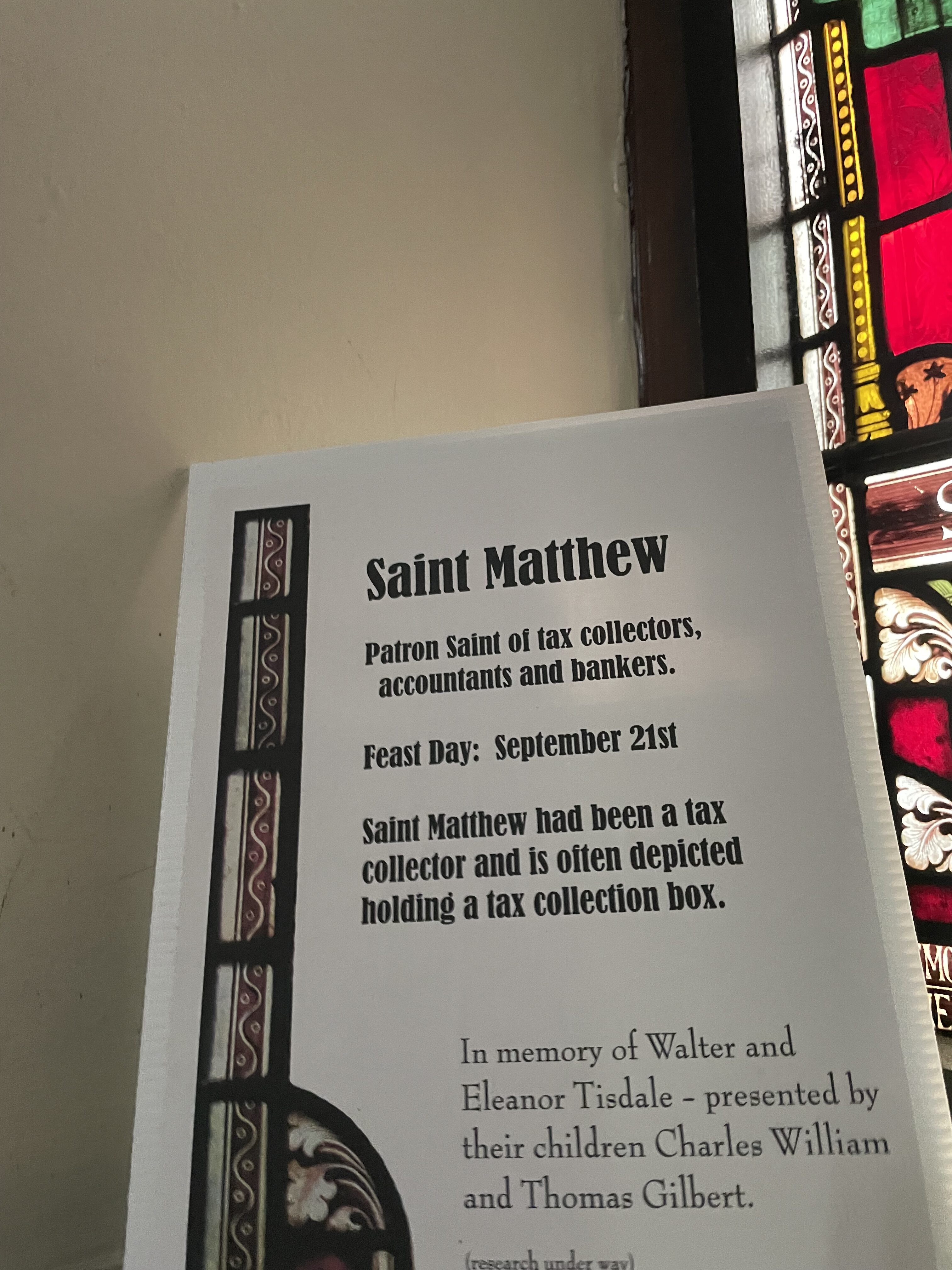
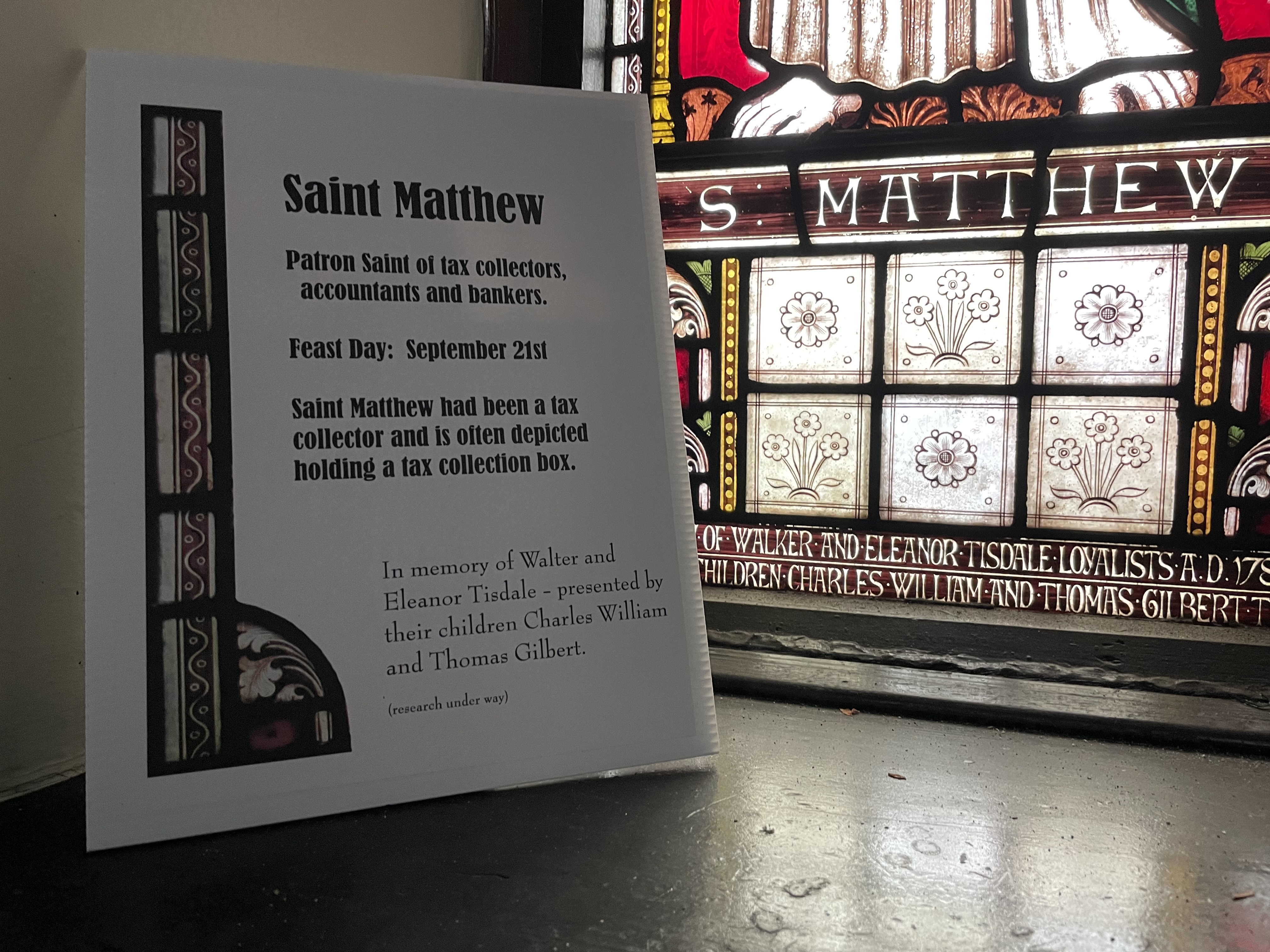
When Walker died in 1857 he is noted as dying at his residence on Germain St. [newspapers describe the Tisdale building at 45 Germain St. which no longer exists). Records indicate that in the 1877 Great Fire in Saint John, the Heirs of Tisdale lost a building on Germain, and Sarah A and Jane Tisdale lost a building on Water St./St. John St.
Walker and Eleanor’s children excluding Charles; however, seemed to remain at Woodlawn and did not move Uptown. Son Thomas died at Woodlawn in 1875 followed by his wife Frederica in 1876. Daughters Jane died at Woodlawn in 1881 and a decade later Ann died.
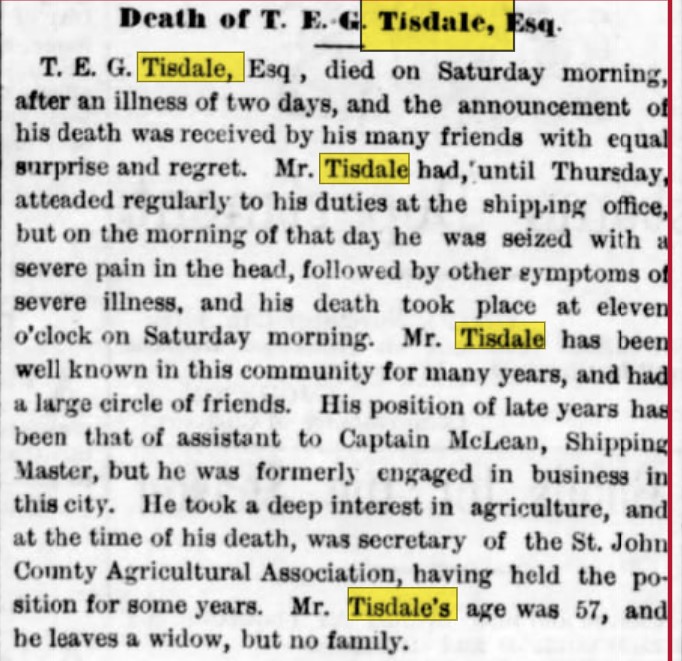
Ann Tisdale had a most unusual death. As noted in the newspaper index, in 1891 “Yesterday morn., Miss Ann Tisdale and her friend and companion, Miss S.C. Jarvis [Sophia Caroline], two aged ladies, breakfasted together. Before the night they were both dead. During the morn., Miss Tisdale complained of being unwell and Dr. Inches was summoned. He pronounced the disease as a malignant of diphtheria and Rev. Canon Brigstocke was summoned. Miss Brigstocke and Miss Eva Drury accompanied him. Miss Jarvis developed symptoms of serious illness and in a few hours both ladies died. Miss Tisdale was a daughter of late Walker Tisdale. Miss Jarvis was a daughter of the late Rev. Dr. Jarvis.” The death registrations indicate both died of Diphtheria.
Newspaper accounts are found below.

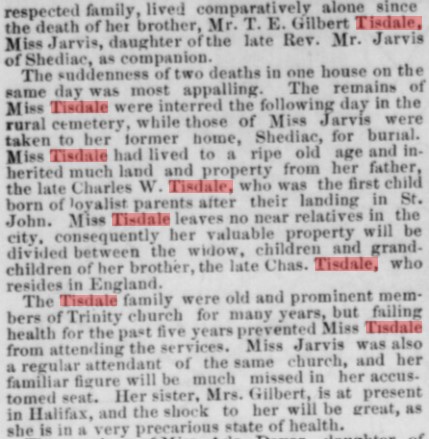
The following account seems to indicate poor sanitary conditions on the property contributed to Ann’s death.

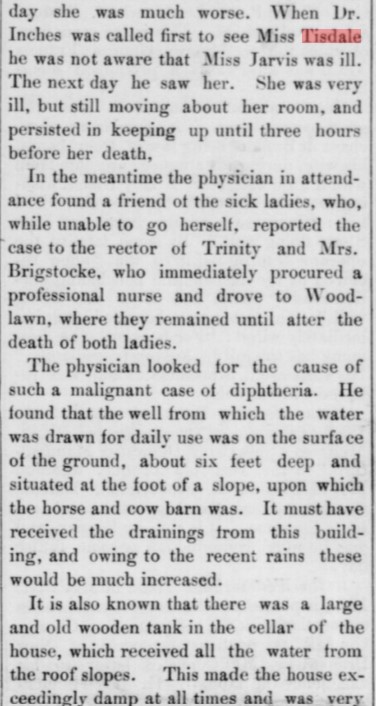
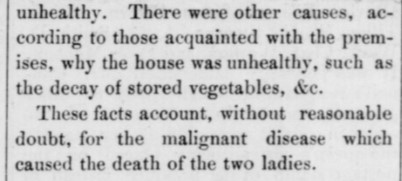
Ann’s will is fascinating. As described in the 1891 Saint John Globe: “Probate was granted Tuesday of the will of the late Miss Sarah A. Tisdale to Messrs. Charles W. Weldon, Robert W. Crookshank, and James McAvity, the three trustees names in the will. The bulk of the property goes to three nieces of the deceased for life, with the remainder over to a grand nephew, William Walker Tisdale Davis with the proviso that the latter will obtain the property in fee, subject to the life interests granted, if he drops his own surname and takes the name of Tisdale instead. Failing this the property ultimately vests in certain relatives in Ontario. Under the will, Woodlawn, the property occupied by the deceased lady at the time of her death, is vested in the trustees to pay the income to one of the nieces in England, but as it is a difficult property to handle it will probably have to be sold by consent of heirs.”

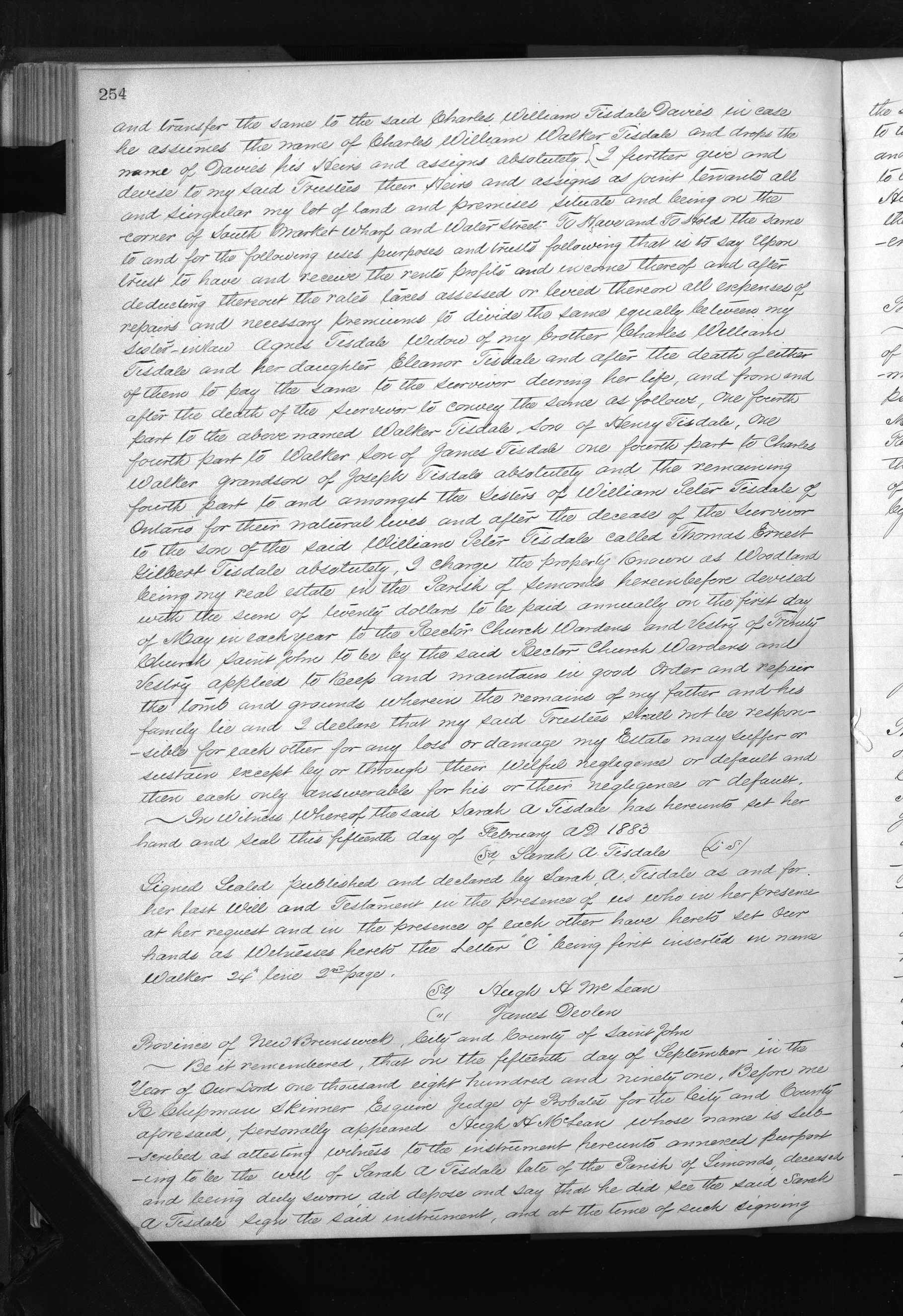
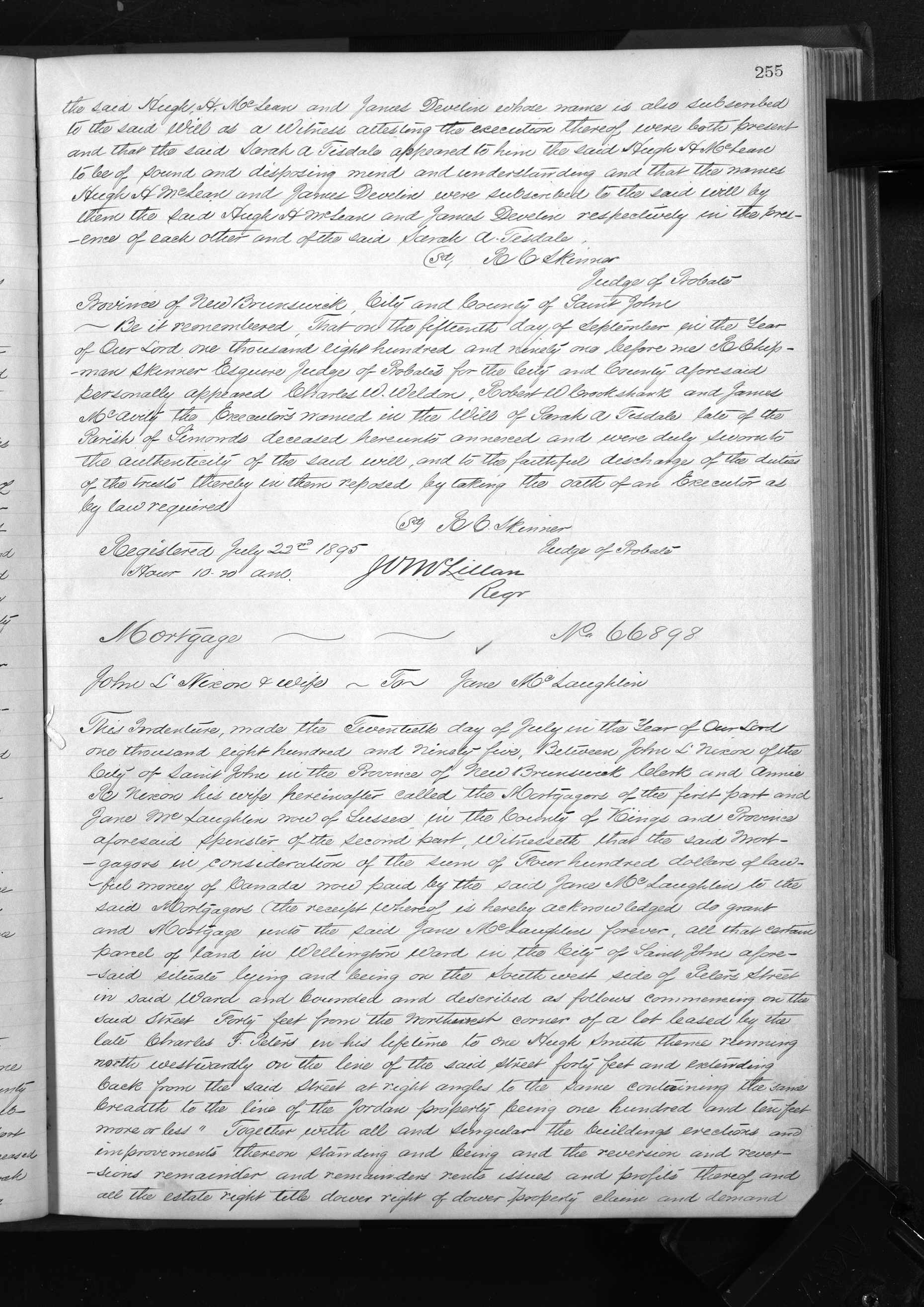
It looks like Ann wanted a Tisdale heir and with only three nieces this was her one shot. Ann’s grand-nephew did change his name in 1901.


1902 London, England article:

In 1892 the Tisdale possessions were being sold and there was an effort to rent the property.
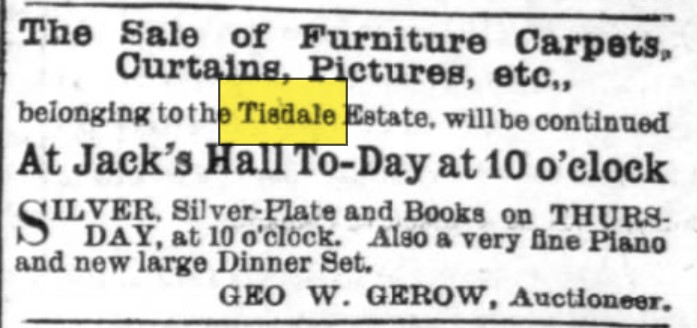
In 1903 the nephew was renting the Tisdale estate. The description below suggests Woodlawn was still standing in 1903.
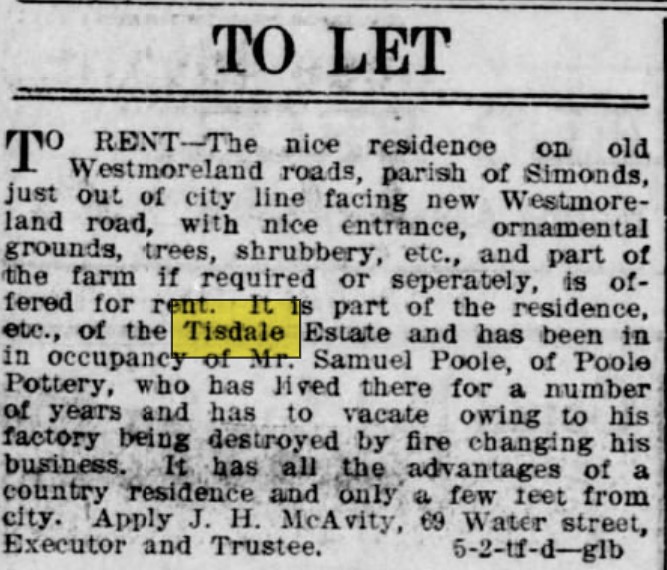
Note that this article suggests Samuel Poole was renting the Tisdale estate due to its proximity to his pottery factory. See image below of the Poole and Foley Pottery company. Someday I want to research the Foley part as the pots from Foley were used inside the greenhouse designed by G. Ernest Fairweather in the Saint John Public Gardens and the Foley home, carpenter Gothic, still stands today.

Of great interest is the street names around “Woodlawn”. As noted in the map below, near the Tisdale “Woodlawn” home is Brittain St. most likely named after Ann’s mother’s family. I also like the planned street names of Germain, Victoria, and Adelaide. These street names were already used in Saint John – Germain was Uptown where Walker had lived, Victoria and Adelaide in Portland now the north end, and Cannon perhaps references the maiden name of Charles Tisdale’s wife Agnes Cannon (his daughter Agnes Cannon Tisdale also predeceased him). Perhaps Anglesea references where the Tisdale family had originated in Wales? [a 1901 parliamentary guide describes the Tisdale family as originally being from Wales then settling in Lancaster, England]
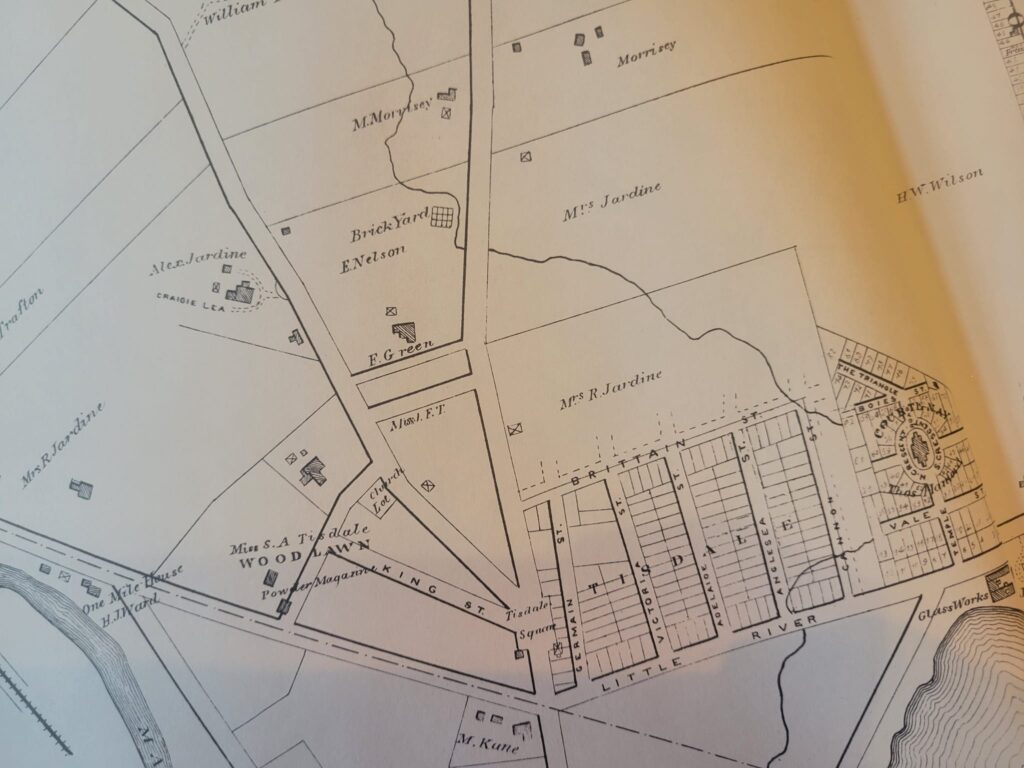
In 1909 there was an application for change in trustee for Sarah Ann Tisdale’s estate.
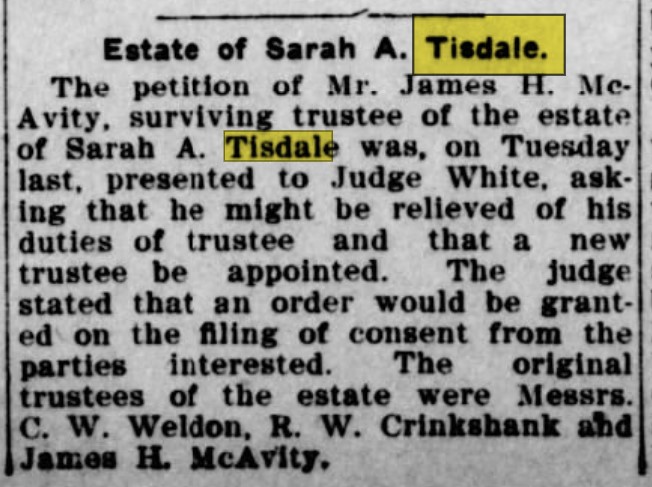
In 1910 real estate values are rising and the Tisdale estate is mentioned.
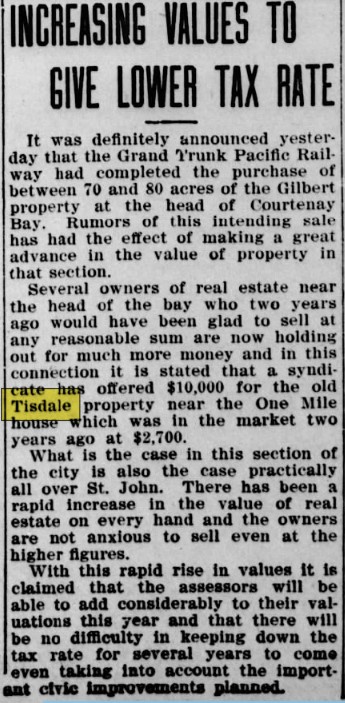
In 1911, more real estate speculation related to the railroad.
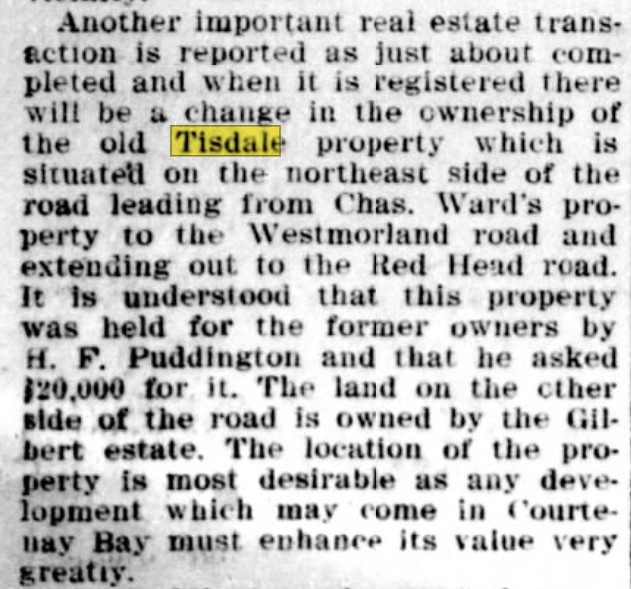
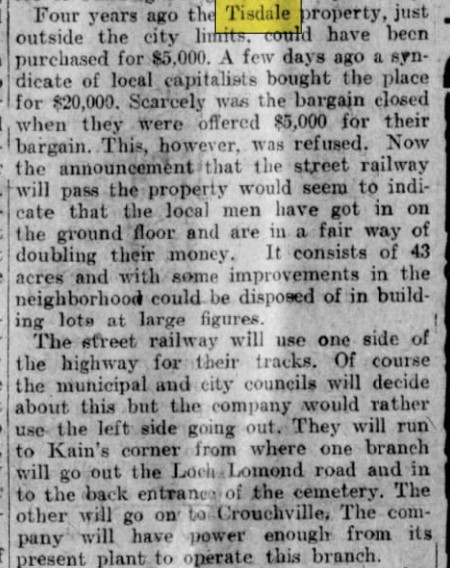
Finally, the property is sold to Walter Allison. The newspaper article from 1911 indicates the property was bought for $20,000 a year previous. Actually, the word “consummated” was used.
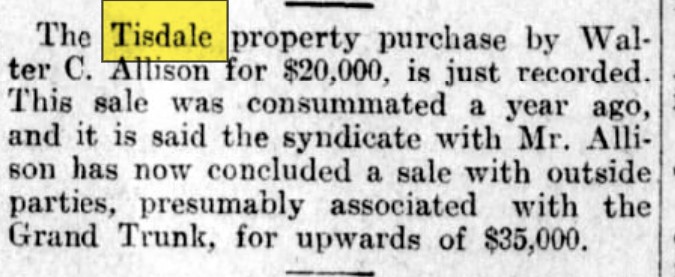


1912 the Tisdale Estate were being developed and strongly advertized.
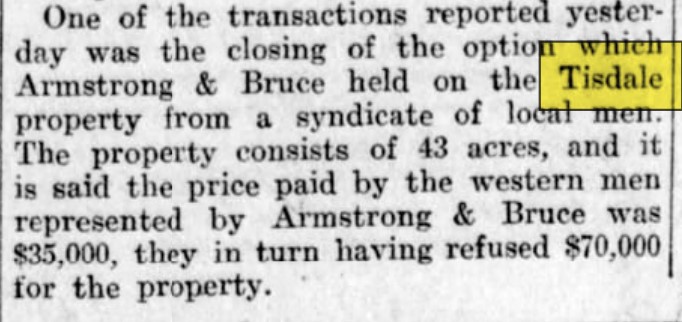

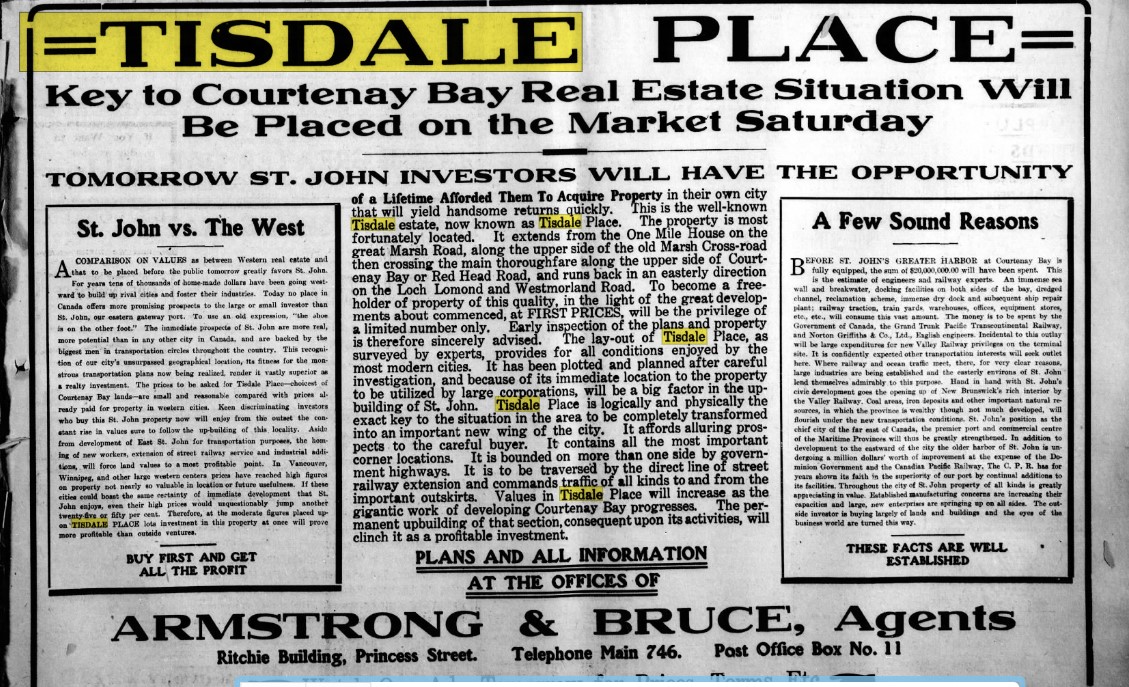
World War One put a damper on real estate development.
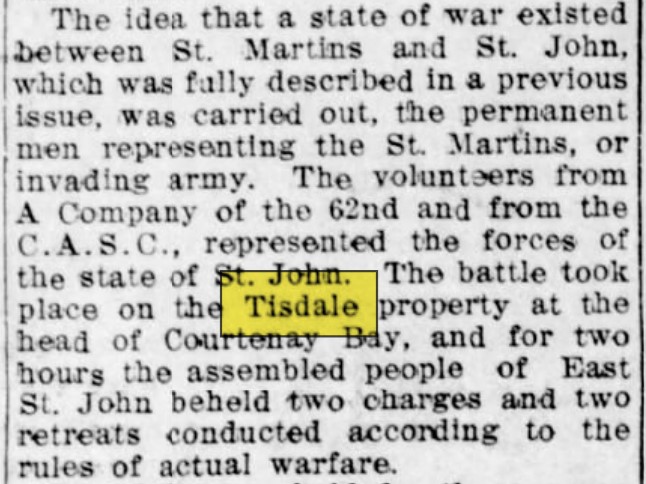
And in 1914, there are still trustees for Sarah Ann Tisdale’s estate. And the maps today indicate the Tisdale developments did not materialize as planned for.
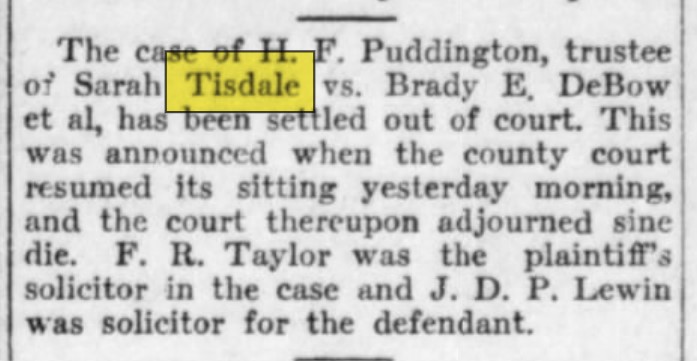
I now have the following questions:
- When was the Woodlawn home and barn demolished?
- What happened to the planned Tisdale development in East Saint John as noted in the 1875 map far earlier than the 1912 planned subdivision?
In 1948, plans to develop roads around Tisdale Place were formally scrapped.
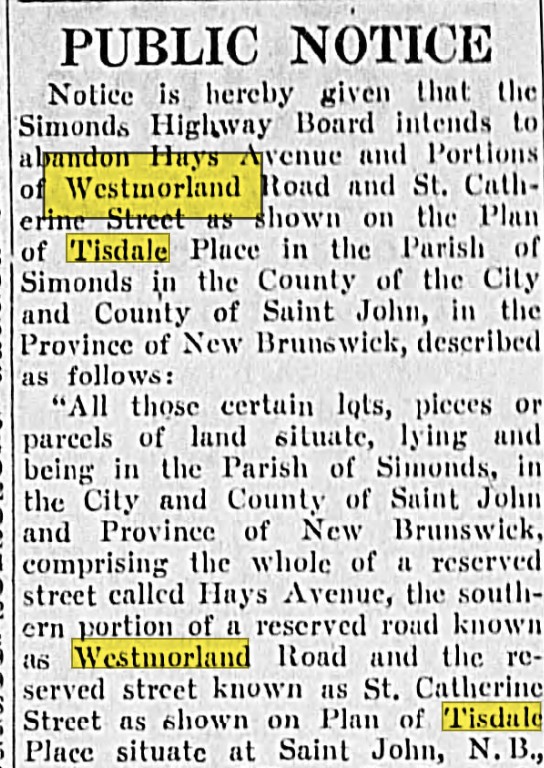

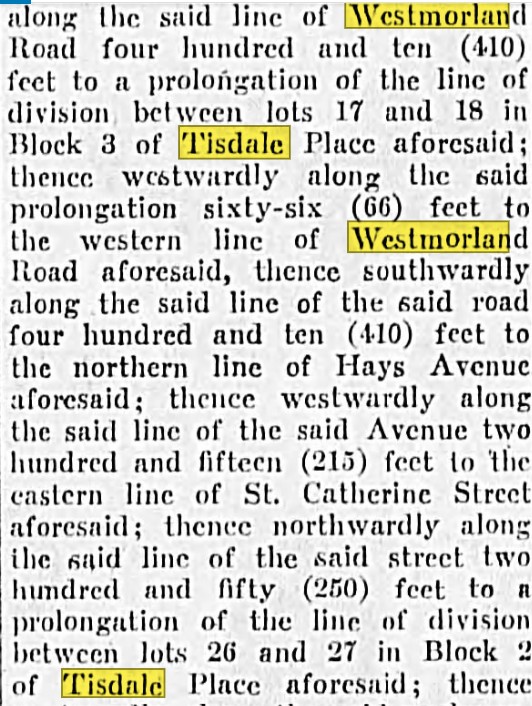
…
